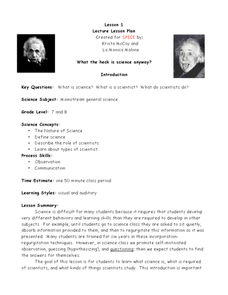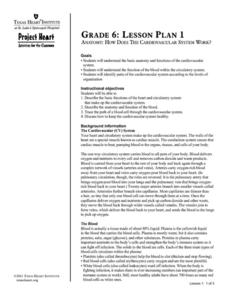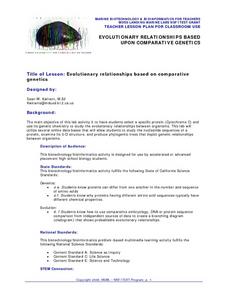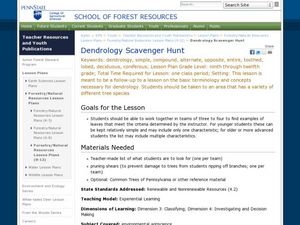Curated OER
Chemistry: Section Review
Review the 5 branches of chemistry and related terms with this worksheet. The focus of these activities is on terms and definitions. Learners answer questions about the study of chemistry, reasons to study chemistry, and pure and applied...
Curated OER
The African and the Pequot in Colonial America
Students determine that the lands the English settled on were owned and inhabited by 70,000 Indians. They consider that the London Company sold land charters to the English, which gave them illegal title to lndian land and that the...
Chicago Botanic Garden
What Can Tree Rings Tell Us About Climate?
Tree rings are slightly thicker on the south side of the tree because it receives more sunlight. Part two in a series of five lessons helps learners analyze tree rings to determine the environmental conditions that caused size...
Curated OER
What the Heck Is Science Anyway?
Here is a 12-page outline of an introductory science lesson. The teacher lectures on what science is, the role of a scientists, different disciplines of science, and the impact of scientific discoveries. Detailed lecture notes are...
Curated OER
Wild About Wildfires
Students conduct a debate. In this wildfire and controlled burning lesson, students watch the video "Legacy of Fire" and discuss the topic of wildland fires and controlled burns. Half of the class researches the arguments for these...
Curated OER
Weave an Aquatic Food Web
Students explore organisms that are part of interconnected food webs. For this food web lesson, students choose an animal and research what the animal eats. Students begin with the food chain and branch out into the...
Texas Heart Institute
Anatomy: How Does the Cardiovascular System Work?
How can the circulatory system compare to a city map? Pupils distinguish the "roadways" and "vehicles" of the cardiovascular system, compare the anatomy and function of veins and arteries, and review different types of blood cells with...
Curated OER
Go to the Source- Your Town's Tap Water
Students investigate their town's tap water. In this water quality activity, students complete a simple taste-testing experiment and online research to investigate tap water.
Curated OER
Evolutionary Relationships Based Upon Comparative Genetics
High schoolers investigate the protein cytochrome c in an attempt to use its genetic chemistry to study possible evolutionary relationships between organisms. The lesson integrates technology with the use computers to perform DNA analysis.
Curated OER
Amazing Transpiration
Learners observe a leaf and discuss the way that water is released from a leaf through its stomata. For this water cycle lesson, young scholars calculate how much water leaves produce from a whole tree.
Curated OER
How Trees Contribute to the Water Cycle
In this water cycle instructional activity, 3rd graders conduct an experiment where they observe and calculate how water transpires in different types of trees. Students engage in a class discussion and use Venn Diagrams to compare...
Curated OER
Habitat, What is That?
Students explore animal habitats. For this environmental stewardship lesson, students match animals to their habitats in a classroom activity. Students also observe a firefly habitat and read Fireflies. Students create bulletin boards...
Curated OER
Dendrology Scavenger Hunt
Students examine leaves that are assigned to them. For this earth science lesson students work in groups and find examples of leaves that the instructor asks for.
Curated OER
The Sounds Of Nature
Second graders investigate the concept of sounds in nature. The sound of a coqui frog is used as an example. They identify species of frogs by listening to the sounds they make. Also, 2nd graders experience and identify other sounds of...
Curated OER
Populations and Ecosystems
Sixth graders examine the factors that influence the stability of ecosystems. They construct a miniature ecosystem in a jar that includes plants, small fish, and snails, record the population changes over a period of four weeks, and...
Curated OER
Butterfly Life Cycle
Second graders engage in a lesson that covers the life cycle of a butterfly. They use the Kidpix software to create a drawing of the life cycle with the help of an illustration given by the teacher as a guide. Then students discuss the...
















